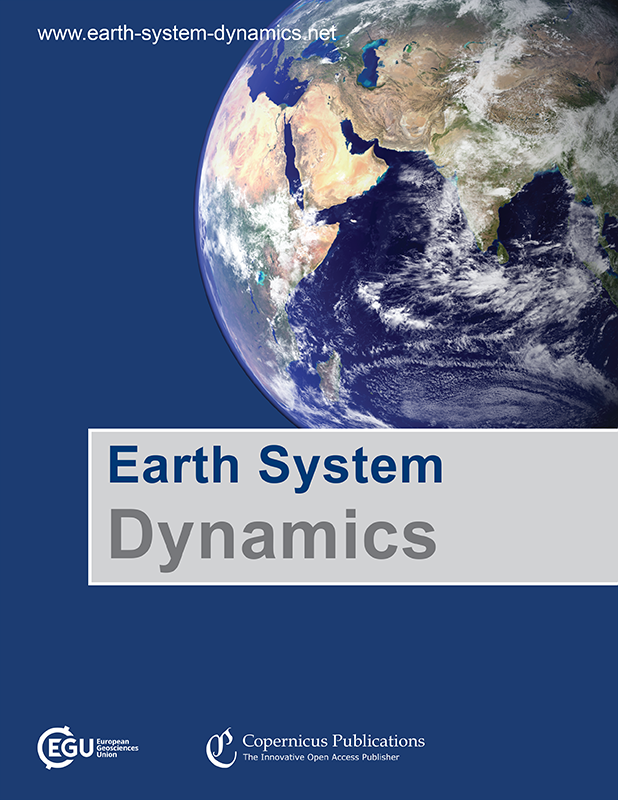太阳地球工程下的印度尼西亚贯通流环流
IF 7.2
2区 地球科学
Q1 GEOSCIENCES, MULTIDISCIPLINARY
引用次数: 0
摘要
摘要印度尼西亚流(ITF)是太平洋和印度洋之间唯一的低纬度通道,其变化对全球气候和生物地球化学循环有重要影响。气候模式一直预测全球变暖会导致 ITF 运输量下降,但尚未对太阳地球工程情景下的 ITF 运输量进行研究。我们使用估算 ITF 的标准参数化方法--修正岛屿规则和浮力强迫--来研究 SSP2-4.5 和 SSP5-8.5 温室气体情景以及 G6solar 和 G6sulfur 地球工程实验下的 ITF,G6solar 和 G6sulfur 地球工程实验分别使用太阳暗化和硫酸盐气溶胶注入策略,将全球平均净辐射强迫从 SSP5-8.5 水平降至 SSP2-4.5 水平。对2080-2100年的六种模式集合均值预测显示,与历史(1980-2014年)ITF相比,G6solar情景下减少了19%,G6sulfur情景下减少了28%,与之相比,SSP2-4.5和SSP5-8.5情景下分别减少了23%和27%。尽管每种情景的标准偏差为 5 %-8 %,但考虑到 2020-2100 年的整个模拟期,所有情景之间都存在显著差异(p<0.05)。因此,在所有情景下都会出现 ITF 明显减弱的情况,但 G6solar 比 G6sulfur 更接近 SSP2-4.5。其他三种情景仅显示海洋上升流导致的强迫减少,而 G6sulfur 试验则显示海洋表面风应力强迫大幅减少,占风 + 上升流驱动的 ITF 传播减少量的 47%(整个模型范围内为 38%-65%)。外热带西边界流的深海上升流也有所减少。本文章由计算机程序翻译,如有差异,请以英文原文为准。
The Indonesian Throughflow circulation under solar geoengineering
Abstract. The Indonesia Throughflow (ITF) is the only low-latitude channel between the Pacific and Indian oceans, and its variability has important effects on global climate and biogeochemical cycles. Climate models consistently predict a decline in ITF transport under global warming, but it has not yet been examined under solar geoengineering scenarios. We use standard parameterized methods for estimating the ITF – the Amended Island Rule and buoyancy forcing – to investigate the ITF under the SSP2-4.5 and SSP5-8.5 greenhouse gas scenarios and the geoengineering experiments G6solar and G6sulfur, which reduce net global mean radiative forcing from SSP5-8.5 levels to SSP2-4.5 levels using solar dimming and sulfate aerosol injection strategies, respectively. Six-model ensemble-mean projections for 2080–2100 show reductions of 19 % under the G6solar scenario and 28 % under the G6sulfur scenario relative to the historical (1980–2014) ITF, which should be compared with reductions of 23 % and 27 % under SSP2-4.5 and SSP5-8.5. Despite standard deviations amounting to 5 %–8 % for each scenario, all scenarios are significantly different from each other (p<0.05) when the whole 2020–2100 simulation period is considered. Thus, significant weakening of the ITF occurs under all scenarios, but G6solar more closely approximates SSP2-4.5 than G6sulfur does. In contrast with the other three scenarios, which show only reductions in forcing due to ocean upwelling, the G6sulfur experiment shows a large reduction in ocean surface wind stress forcing accounting for 47 % (38 %–65 % across the model range) of the decline in wind + upwelling-driven ITF transport. There are also reductions in deep-sea upwelling in extratropical western boundary currents.
求助全文
通过发布文献求助,成功后即可免费获取论文全文。
去求助
来源期刊

Earth System Dynamics
GEOSCIENCES, MULTIDISCIPLINARY-
CiteScore
13.20
自引率
5.50%
发文量
61
审稿时长
36 weeks
期刊介绍:
Earth System Dynamics (ESD) is a not-for-profit international scientific journal committed to publishing and facilitating public discussion on interdisciplinary studies focusing on the Earth system and global change. The journal explores the intricate interactions among Earth's component systems, including the atmosphere, cryosphere, hydrosphere, oceans, pedosphere, lithosphere, and the influence of life and human activity. ESD welcomes contributions that delve into these interactions, their conceptualization, modeling, quantification, predictions of global change impacts, and their implications for Earth's habitability, humanity, and the future dynamics in the Anthropocene.
 求助内容:
求助内容: 应助结果提醒方式:
应助结果提醒方式:


